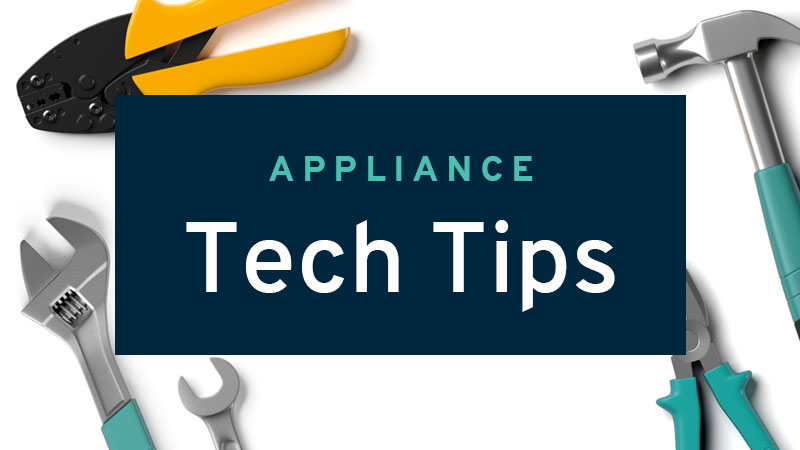Troubleshoot Kitchenaid Microwave Fan
**NOTICE**
Due to the danger and complexity of electronic equipment repair, the following technical tip is intended for professional reference only. Please refer to manufacturer’s recommendations as Encompass does not guarantee the accuracy, reliability or safety of this information.
If your KitchenAid microwave fan is not working, there could be a variety of issues. This post provides some possible causes the fan may stop working on these popular KitchenAid microwave models:
KCMG125DBL0
KCMG125DWH0
KCMG125EAL0
KCMG125EBU0
KCMG125ERC0
KCMS135GBL0
KHMC1857WBL1
KHMS2040BBL0
KHMS2040BSS0
KHMS2040BWH0
KHMS2040WBL1
KHMS2040WSS1
KHMS2040WSS3
KHMS2040WWH1
YKHMS2040BS0
YKHMS2040BS1
YKHMS2040BS2
YKHMS2040WB0
YKHMS2040WS0
YKHMS2040WS1
YKHMS2040WW0
Fan Motor
One of the most common reasons a microwave fan stops working is a problem with the fan motor. Here’s how to test the fan motor with a multimeter:
- Unplug microwave and remove from wall or cabinet.
- Remove microwave casing / cabinet and locate fan motor located at the back of the microwave.
- Attempt to manually rotate the fan. If it can’t be rotated, it’s faulty and will need to be replaced.
- If it can be rotated, use multimeter to test for continuity, which is shown by reading of 0.
- If it has continuity, this is not the cause, so reassemble the microwave and read on.
Charcoal Filter
 If the microwave is an over-the-range model, check to see if the charcoal filter is clogged. Over time the filter absorbs all sorts of pollutants and will eventually need to be replaced. For regular maintenance, replace the filter regularly to ensure the microwave operates properly.
If the microwave is an over-the-range model, check to see if the charcoal filter is clogged. Over time the filter absorbs all sorts of pollutants and will eventually need to be replaced. For regular maintenance, replace the filter regularly to ensure the microwave operates properly.
Here’s how to inspect the charcoal filter:
- Unplug microwave.
- Locate charcoal filter behind exhaust air outlet grill and remove grill. Each KitchenAid model has slightly different way to remove grill, so consult product manual for directions.
- After removing grill, take out filter and look for any damage or build up of debris.
- If filter is damaged, blocked or been in use for longer than the manufacturer recommends, replace it. Filters can be found at most major retailers; just make sure it’s matched to the correct microwave model.
Grease Filter
Another reason the fan motor stops working is a clogged grease filter, which protects the exhaust system by trapping oils and fats from food heated in the microwave.
Here’s how to inspect a grease filter:
- Unplug microwave.
- Find the filter on the bottom of the microwave held in place with spring clips and remove it.
- Thoroughly inspect the filter to see if it is damaged or clogged.
- If it’s clogged, clean it with soap and water and put it back in place.
- If it’s damaged or too clogged to clean properly, replace it. Filters can be found at most major retailers; just make sure it’s matched to the correct microwave model.
Damper Assembly
Dampers are intended to prevent exterior air from entering through the microwave fan, and it can fail. The damper is a flap made of either metal or plastic and is usually spring loaded. Here’s how to check to see if the damper assembly is faulty:
- Unplug microwave and remove from wall or cabinet.
- Remove microwave case / cabinet to access damper assembly.
- Check for signs of wear and tear, that it’s prevented from opening and closing or damaged in some way.
- Replacement dampers can be found at major retailers that sell home appliance parts.
Thermostat
Microwave thermostats monitor air temperature, and turn on fan as needed. If it stops working, the fan will not turn on. Here’s how to check it:
- Unplug microwave.
- Check thermostat with multimeter, which can tell whether there is continuity. If not, replace.
Main Control Board
If all else fails, the microwave’s main control board may need to be replaced, but that should be the absolute last resort. Before replacing this part, check the exhaust fan motor and its wiring. If the motor is not getting power, it could be the result of a faulty main control board.
Visit Fred’s Appliance Academy to learn more about the training provided in appliance repair.
Special thanks to Fred’s Appliance Academy for this helpful tip!

Want more tips? Click here to see all electronics and appliance tips!


